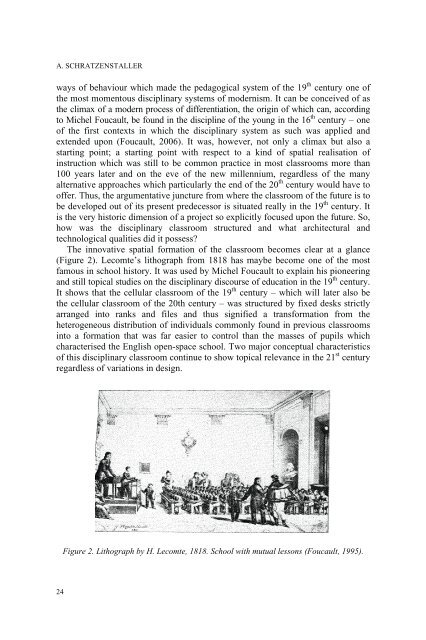Classroom of the Future - Sense Publishers
Classroom of the Future - Sense Publishers
Classroom of the Future - Sense Publishers
You also want an ePaper? Increase the reach of your titles
YUMPU automatically turns print PDFs into web optimized ePapers that Google loves.
A. SCHRATZENSTALLER<br />
ways <strong>of</strong> behaviour which made <strong>the</strong> pedagogical system <strong>of</strong> <strong>the</strong> 19 th century one <strong>of</strong><br />
<strong>the</strong> most momentous disciplinary systems <strong>of</strong> modernism. It can be conceived <strong>of</strong> as<br />
<strong>the</strong> climax <strong>of</strong> a modern process <strong>of</strong> differentiation, <strong>the</strong> origin <strong>of</strong> which can, according<br />
to Michel Foucault, be found in <strong>the</strong> discipline <strong>of</strong> <strong>the</strong> young in <strong>the</strong> 16 th century – one<br />
<strong>of</strong> <strong>the</strong> first contexts in which <strong>the</strong> disciplinary system as such was applied and<br />
extended upon (Foucault, 2006). It was, however, not only a climax but also a<br />
starting point; a starting point with respect to a kind <strong>of</strong> spatial realisation <strong>of</strong><br />
instruction which was still to be common practice in most classrooms more than<br />
100 years later and on <strong>the</strong> eve <strong>of</strong> <strong>the</strong> new millennium, regardless <strong>of</strong> <strong>the</strong> many<br />
alternative approaches which particularly <strong>the</strong> end <strong>of</strong> <strong>the</strong> 20 th century would have to<br />
<strong>of</strong>fer. Thus, <strong>the</strong> argumentative juncture from where <strong>the</strong> classroom <strong>of</strong> <strong>the</strong> future is to<br />
be developed out <strong>of</strong> its present predecessor is situated really in <strong>the</strong> 19 th century. It<br />
is <strong>the</strong> very historic dimension <strong>of</strong> a project so explicitly focused upon <strong>the</strong> future. So,<br />
how was <strong>the</strong> disciplinary classroom structured and what architectural and<br />
technological qualities did it possess?<br />
The innovative spatial formation <strong>of</strong> <strong>the</strong> classroom becomes clear at a glance<br />
(Figure 2). Lecomte’s lithograph from 1818 has maybe become one <strong>of</strong> <strong>the</strong> most<br />
famous in school history. It was used by Michel Foucault to explain his pioneering<br />
and still topical studies on <strong>the</strong> disciplinary discourse <strong>of</strong> education in <strong>the</strong> 19 th century.<br />
It shows that <strong>the</strong> cellular classroom <strong>of</strong> <strong>the</strong> 19 th century – which will later also be<br />
<strong>the</strong> cellular classroom <strong>of</strong> <strong>the</strong> 20th century – was structured by fixed desks strictly<br />
arranged into ranks and files and thus signified a transformation from <strong>the</strong><br />
heterogeneous distribution <strong>of</strong> individuals commonly found in previous classrooms<br />
into a formation that was far easier to control than <strong>the</strong> masses <strong>of</strong> pupils which<br />
characterised <strong>the</strong> English open-space school. Two major conceptual characteristics<br />
<strong>of</strong> this disciplinary classroom continue to show topical relevance in <strong>the</strong> 21 st century<br />
regardless <strong>of</strong> variations in design.<br />
24<br />
Figure 2. Lithograph by H. Lecomte, 1818. School with mutual lessons (Foucault, 1995).














